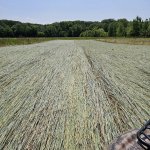Headed down the Rabbit hole, going all in on the Grant Woods Release Process. Crimped some Rye, it worked well. But didn't plant into the standing Rye before crimping as prescribed by Grant Woods due to the drought, soil is dry, and the Rye took up even more moisture, not ideal....will take my chances once some rain comes, if ever.
This plot was planted last Fall with Green Cover Fall Release blend, i think it had something like 12 varieties in it. Looks like 4 of the 12 have over wintered Elbon Cereal Rye, Kentucky Pride Crimson Clover, Fixation Clover and some Winter Wheat.
Most impressive part, very few weeds,
This plot was planted last Fall with Green Cover Fall Release blend, i think it had something like 12 varieties in it. Looks like 4 of the 12 have over wintered Elbon Cereal Rye, Kentucky Pride Crimson Clover, Fixation Clover and some Winter Wheat.
Most impressive part, very few weeds,



